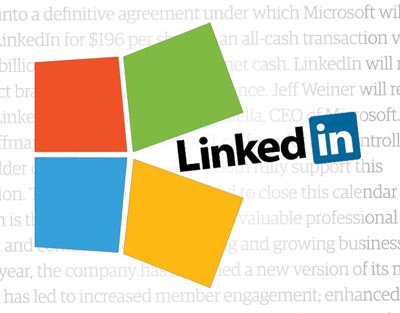In the ever-evolving landscape of mergers and acquisitions, Microsoft’s acquisition of LinkedIn in 2016 stands as a landmark deal that showcases strategic vision and the potential for transformation.
Financing
Let’s begin by examining how Microsoft financed this monumental acquisition. The purchase price for LinkedIn, which amounted to $26.2 billion, was substantial, making it one of the largest tech deals at the time. Microsoft employed a combination of cash reserves and debt to fund the acquisition:
- Cash: Microsoft utilized a significant portion of its cash reserves to cover the purchase price. Their substantial cash holdings allowed them to make a sizable upfront payment.
- Debt Financing: To complement their cash resources, Microsoft issued bonds to raise additional funds. This debt financing strategy helped them manage the financial aspects of the acquisition efficiently.
Synergies
The acquisition of LinkedIn presented Microsoft with a wealth of opportunities to leverage synergies across various facets of their business:
- Professional Network Integration: Microsoft saw immense potential in integrating LinkedIn’s vast professional network with its own suite of productivity tools, including Office 365. This integration allowed users to seamlessly connect with their professional contacts, enhancing the value of Microsoft’s productivity offerings.
- AI and Data Insights: LinkedIn’s rich data on professional connections and career trajectories provided a fertile ground for the development of AI-driven applications. Microsoft capitalized on this by integrating LinkedIn data to enhance its cloud-based services, particularly in areas like CRM and human resources.
- Talent Solutions: LinkedIn’s Talent Solutions platform, used by recruiters and HR professionals, complemented Microsoft’s Dynamics 365 suite. The synergy between these platforms enabled more effective recruitment and talent management processes for businesses.
- Content and Learning: Microsoft integrated LinkedIn Learning, an online learning platform, into its ecosystem. This move expanded the range of educational resources available to users, fostering skills development and professional growth.
- Advertising and Marketing: LinkedIn’s advertising and marketing capabilities were combined with Microsoft’s advertising platforms. This allowed for more targeted and data-driven marketing efforts, enhancing the effectiveness of digital advertising campaigns.
The Type of Acquisition
Microsoft’s acquisition of LinkedIn was a vertical acquisition. Just as Microsoft strategically expanded its service offerings through the vertical acquisition of LinkedIn, students can enhance their academic portfolio by utilizing bachelorarbeit schreiben lassen services to expertly craft their thesis, ensuring a comprehensive and professional presentation of their research and insights.
The Acquisition Process
The acquisition process for Microsoft and LinkedIn involved several key steps:
- Due Diligence: Extensive due diligence was conducted to assess the financial health and strategic fit of LinkedIn. Microsoft evaluated the potential synergies and opportunities for integration.
- Negotiations: Negotiations took place to finalize the terms of the deal, including the purchase price and other essential aspects of the transaction.
- Regulatory Approval: Regulatory bodies scrutinized the merger to ensure compliance with antitrust regulations. After receiving regulatory approval, the deal moved forward.
- Integration: Post-acquisition integration efforts aimed at combining the two companies’ operations, systems, and technologies. This process was meticulous to ensure a seamless transition.
Post-Acquisition Performance
The success of the Microsoft-LinkedIn acquisition can be measured by several key indicators:
- Revenue Growth: Microsoft’s revenue stream diversified with the integration of LinkedIn’s services. The acquisition contributed to revenue growth through increased subscription numbers, advertising revenue, and sales of integrated products.
- User Engagement: The integration of LinkedIn into Microsoft’s ecosystem led to improved user engagement across both platforms. Users benefited from the seamless integration of their professional networks with productivity tools, enhancing their overall experience.
- AI and Data-Driven Services: Microsoft harnessed LinkedIn’s data for AI-driven applications, offering personalized insights and recommendations. This data-driven approach improved user satisfaction and attracted new customers.
- Enterprise Solutions: LinkedIn’s Talent Solutions and Dynamics 365 were seamlessly integrated, resulting in more robust enterprise solutions for human resources and customer relationship management. This integration attracted enterprises seeking comprehensive solutions.
- Financial Performance: Microsoft’s financial performance saw sustained growth post-acquisition. The increased revenue and diversification of services contributed to strong financial results.
- Productivity Tools: The integration of LinkedIn’s professional network with Microsoft’s productivity suite enhanced the value proposition of Office 365. Users found increased utility in their professional workflows.
In conclusion, Microsoft’s acquisition of LinkedIn exemplifies a successful M&A strategy that focused on leveraging synergies, integrating technologies, and expanding service offerings. The acquisition enhanced Microsoft’s position in the tech industry, strengthened its competitive edge, and provided new avenues for growth.
